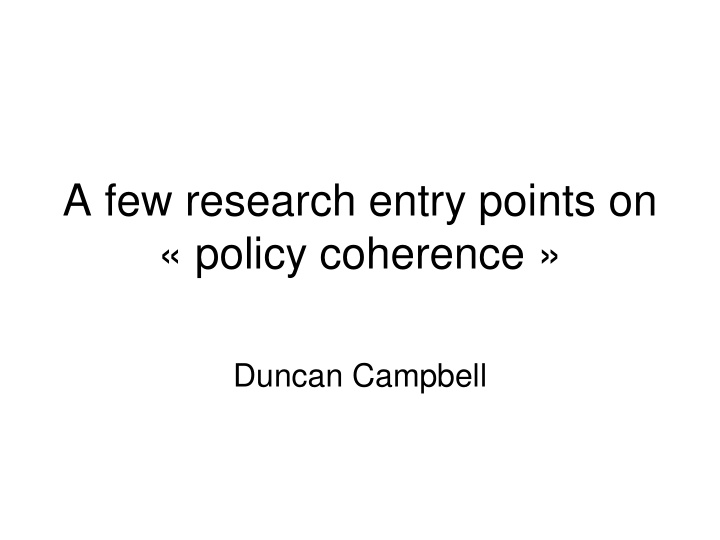



A few research entry points on « policy coherence » Duncan Campbell
Policy coherence = • « the systematic promotion of mutually reinforcing policies across government departments and agencies creating synergies towards achieving the defined objective. » • For present discussion, coherence equals integration equals coordination, etc.
Question One: if PC is such an obvious public good why are we only now talking about it? • the « philological » answer reveals a distinction between « policy coherence » and « policy coherence for development ». • The latter is from mid-1990s, refers to aid effectiveness debates, donor coordination, and domestic policies of OECD and their effect on developing countries • Complexity : proliferation of policy domains • Erosion of discrete policy spheres with globalization, e.g. trade policy becomes employment policy, or without globalization, e.g. environmental policy becomes part of industrial policy and employment policy
Question Two: if PC is such an obvious public good, then why doesn’t it just happen? • …sometimes it perhaps ought not to, e.g. the Washington consensus • A plethora of disciplinary approaches to the answer: – Bounded rationality in economics – Territory (turf protection) in economic anthropology – Organization and inter-organization theory (e.g. bureaucracy, and cultural misunderstanding) – Information asymmetries (i.e. different constituencies with different perceptions of self-interest) – Governance incentives, e.g. ministerial power in Nepal
Distinguishing between intended and unintended policy incoherence • Intended incoherence: the North favours development; trade leads to development; trade from developing countries is impeded by various barriers imposed by the North. (key issues here are (1) implied policy priority arising from budget constraint or, (2) from vested interests (hostage) • Unintended incoherence: examples would include the « negative correlation » between neediest and beneficiaries of a successful Doha (showing policy sequencing), or the fate of isolated good policy, e.g. anti- discrimination
The effort in South Africa • First, define decent work as the primary policy objective • Accommodating, jobs-friendly macroeconomic policies: – Fiscal policies (EPWP, Jobs Fund, DFIs) – Debate over exchange rate policy – Reforming monetary policy – shelter IDC from commercial balance sheet constraints
Continued … • Industrial policy with discrete sector-level support, a major criterion of which is labour-absorptive capacity • Trade policy: expand geography and promotion of exports • Supply-side strategy, revamp STBs, and innovations such as training layoff scheme
Sri Lanka • Promotion of garment industry through tax holidays • Resulting fiscal deficit crowding out (job-creating) private investment elsewhere • Fiscal deficit meant no investment in rural infrastructure, thus no investment in labour-intensive agriculture • Need to increase productivity in garments, meanwhile, facing global competition, job-reducing • Subsidizing capital investment – distortion of cost structure resulting in fewer jobs • No obvious plan for economic diversification (70 %) in service sector
Nepal (and Integration) • Paramount importance is employment creation (sector 2) • One key is investment, impeded by labour market reform (sector 2 and 4) • Key to reform is sector 3 (social protection) • Sector 4 (social dialogue) now includes maoists (sector 1 – FoA)
Recommend
More recommend